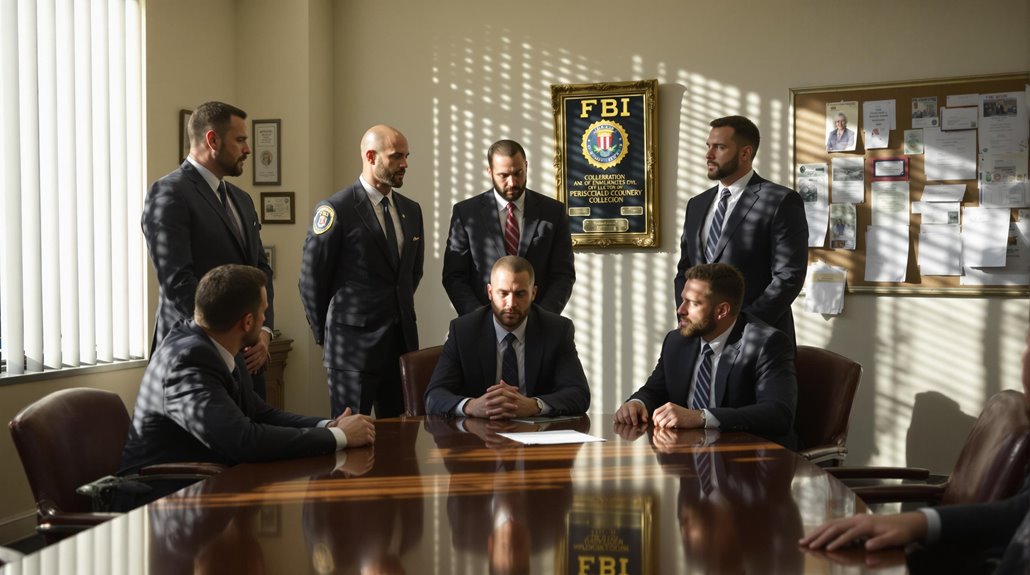Why Doesn't the US Military Allow Beards?
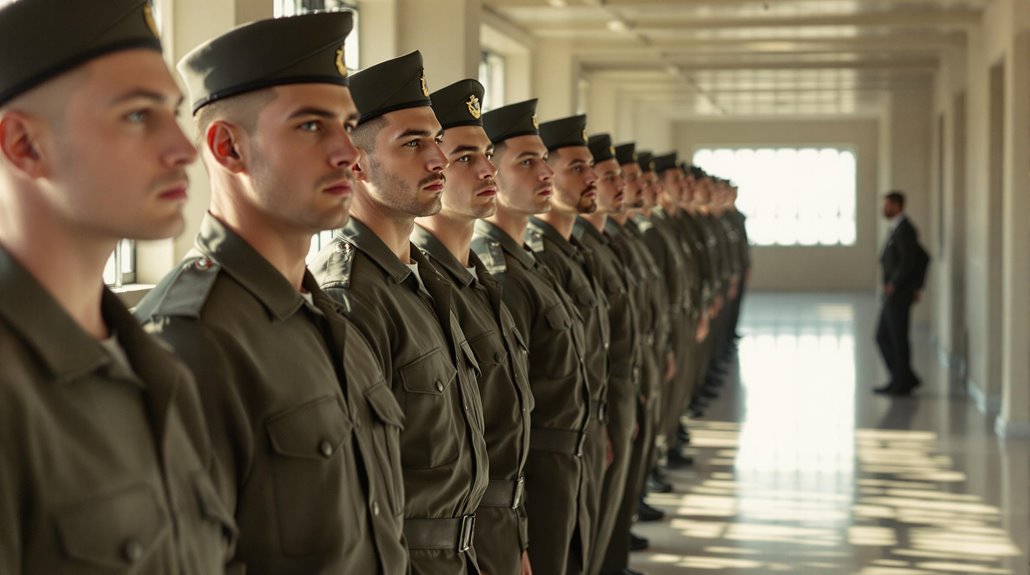
You might wonder why the U.S. military bans beards. It's primarily for safety and uniformity. Beards can interfere with the seal of gas masks, crucial for protection against chemical threats. A clean-shaven look also fosters uniformity and discipline among service members. While the military respects cultural and religious diversity, it's balancing these with operational demands. Some branches have started allowing facial hair under specific conditions, especially for religious reasons. Legal challenges and comparisons to other countries with more lenient policies are pushing the U.S. military to reconsider its stance. There's more to explore about this evolving topic.
Historical Grooming Standards
Throughout history, military grooming standards have shifted dramatically, especially concerning beards. In the 19th century, beards were commonplace among military personnel, symbolizing strength and experience. However, as time marched on, these grooming standards evolved, largely due to the introduction of chemical warfare. Gas masks became crucial, requiring a clean-shaven face to guarantee a proper seal. This necessity influenced significant changes, particularly during and after World War I, when regulations tightened considerably.
In the Navy, beards were once a part of naval tradition, reflecting a rich history of seafaring life. Yet, in 1985, the Navy instituted a beard ban, reversing earlier allowances. The primary reason cited was the need for uniformity among military personnel. This shift highlighted a broader cultural resistance to change within military grooming standards, even as historical regulations adapted to new realities.
Furthermore, the issue of religious accommodations emerged, challenging these grooming standards. Legal challenges, especially from Sikh recruits, have sparked ongoing discussions about modernizing policies to respect religious practices while maintaining necessary military protocols. These historical grooming standards, deeply rooted in tradition and practicality, continue to evolve in response to societal and operational needs.
Safety and Equipment Concerns
Safety and equipment concerns are a primary reason the U.S. military doesn't allow beards. One of the main issues is that beards can compromise the seal of a gas mask, which is essential for protecting personnel during chemical or biological threats. Even though some research indicates short beards might not greatly affect gas mask functionality, military regulations remain strict. This is to guarantee uniformity and uphold safety standards across the board.
Facial hair poses potential operational risks, particularly in emergencies where the effectiveness of safety equipment cannot be compromised. For instance, untrimmed beards might interfere with equipment and response protocols, leading to potentially disastrous outcomes. As a result, the military adopts a conservative approach by enforcing strict grooming regulations that prohibit beards.
The Navy, for instance, reinstated its grooming standards banning beards in 1985, driven by concerns over uniformity and the operational risks associated with facial hair. Ongoing studies, including one expected in 2023, continue to evaluate the impact of facial hair on gas mask effectiveness. These findings could influence future grooming policies, but for now, the focus remains on maintaining safety and uniformity.
Cultural and Religious Considerations
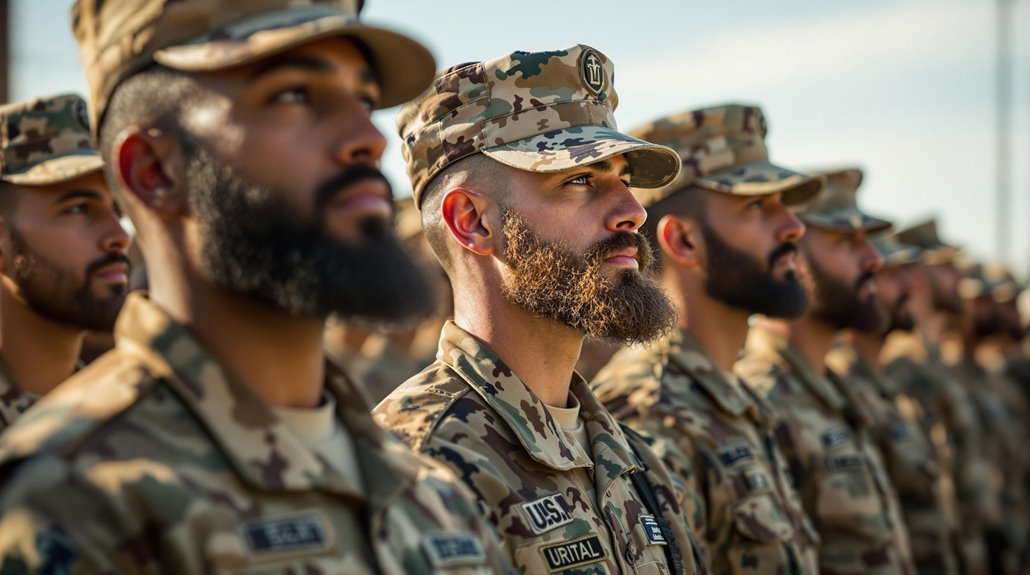
Cultural and religious considerations are increasingly shaping the U.S. military's grooming policies. As society evolves, there's growing pressure on the military to recognize the diverse backgrounds of its service members. This shift is evident in the cases of Sikh Marines and others seeking religious accommodation to allow beards. The Army and Air Force have taken steps to permit beards under specific circumstances, acknowledging the importance of cultural considerations and religious freedom.
Military traditions have emphasized uniformity and discipline, but these values are now being balanced with the need for inclusion. Some service members face medical conditions that prevent them from shaving, and social media has amplified their voices, pushing for change. Public perception and military cohesion are often cited as reasons for maintaining strict grooming standards. However, there's a clear trend towards reevaluating these policies to better align with modern societal values.
The ongoing evaluation of beard policies reflects a broader initiative to improve diversity, equity, and inclusion within the armed forces. By accommodating religious and cultural practices, the military can create an environment where all service members feel respected and valued, fostering a more inclusive atmosphere.
Legal Challenges and Lawsuits
Amid growing demands for religious accommodations, legal challenges against the U.S. military's grooming policies have intensified. Sikh Marine recruits have taken the lead, filing lawsuits that challenge these regulations. They're asserting their right to grow facial hair for religious reasons, pushing the military to reconsider its grooming standards. It's not just the Marines facing scrutiny; four sailors have also filed lawsuits seeking religious exemptions to the Navy's grooming requirements. These cases highlight the growing tension between maintaining uniformity and respecting religious diversity among military members.
In a landmark decision, the U.S. Court of Appeals sided with Sikh recruits, allowing them to maintain their beards during boot camp. This ruling sets a significant precedent, showing that the military might need to adjust its stance on facial hair. The outcomes of these ongoing legal battles could compel the Navy, and potentially other branches, to reevaluate their grooming rationale. Balancing safety, uniformity, and religious practices remains a complex challenge. As these lawsuits unfold, they stress the importance of finding a middle ground that honors both individual religious beliefs and the military's operational needs.
Diversity and Inclusion Efforts
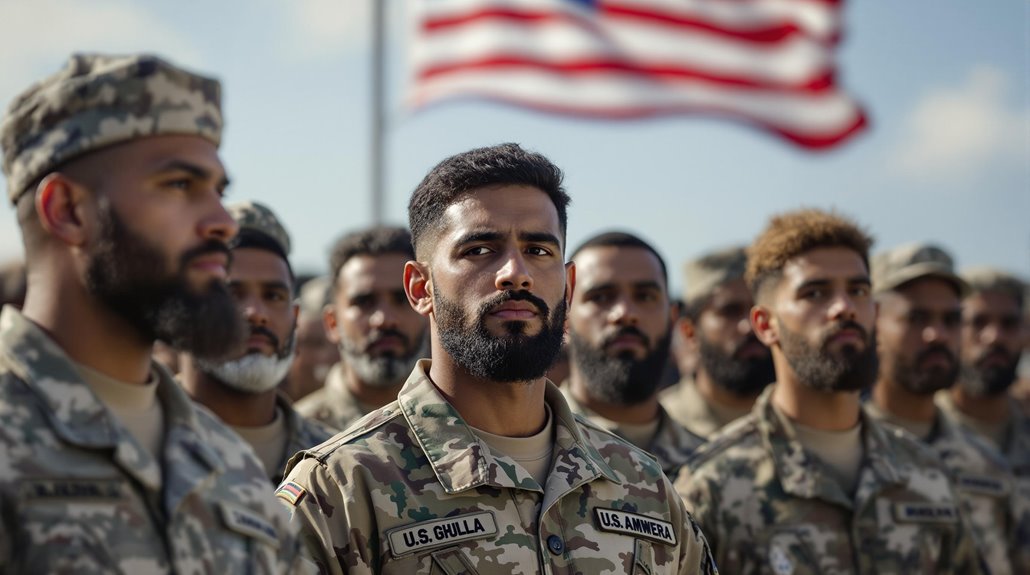
Reviewing the U.S. military's grooming standards is a vital step towards fostering diversity and inclusion within its ranks. As part of these initiatives, the military is reassessing its policies on facial hair to accommodate the distinct religious and cultural practices of its service members. The recent lawsuit filed by Sikh Marines has underscored the significance of allowing beards for religious reasons, prompting the Navy to reevaluate its grooming standards. This move highlights the need to balance safety regulations, like the necessity for gas mask seals, with the goal of inclusivity.
You might wonder how policy changes can impact diversity. The military's ongoing evaluation recognizes that equitable grooming standards can improve the representation of different cultural backgrounds and religious beliefs within the armed forces. Advocacy groups, such as the Sikh Coalition, are pivotal in pushing for these changes, emphasizing the respect for individual expression and religious practices.
Feedback from service members also reveals a growing desire for policies that reflect modern societal values. By accommodating facial hair for religious reasons, the military can reinforce its commitment to diversity and inclusion, ultimately creating a more welcoming environment for all.
Comparisons With Other Militaries
While the U.S. military grapples with updating its grooming standards to better reflect diversity and inclusion, it's informative to look at how other countries examine facial hair in their armed forces. Militaries like the British, Canadian, Dutch, and Swedish allow their personnel to grow beards under specific guidelines, emphasizing personal expression and morale. Conversely, the U.S. Navy and Marine Corps mainly restrict facial hair to mustaches, allowing beards only for medical or religious reasons. This illustrates a significant difference in approach compared to several allied nations.
Countries such as Iran and Pakistan even encourage beards as a sign of cultural or religious identity. Meanwhile, the U.S. military's ban is deeply rooted in concerns about uniformity, discipline, and the effectiveness of gas masks. Senior leaders in the U.S. Armed Forces emphasize these safety concerns as a primary reason for maintaining strict grooming standards.
In contrast, France and Germany have adopted more flexible grooming policies, permitting beards in certain circumstances. This trend towards inclusivity in other nations highlights a potential area of growth for the U.S. military, as ongoing legal challenges and advocacy for religious freedoms push for more inclusive facial hair policies.
Potential Policy Changes
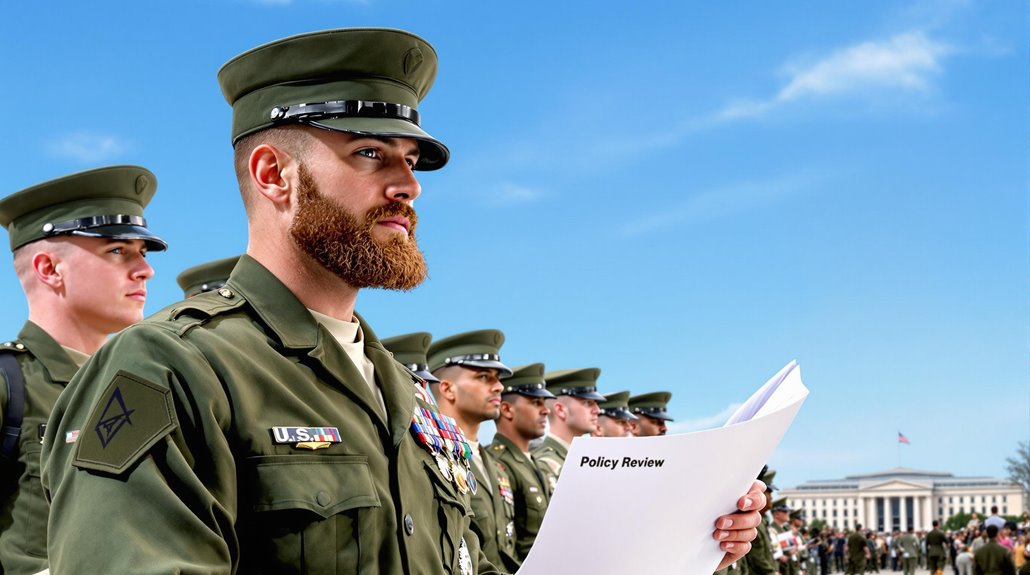
As the U.S. military considers potential policy changes regarding facial hair, the discussion pivots around balancing safety concerns with demands for greater inclusivity. The Navy recently conducted a study on beards and their impact on gas mask seals, a key factor in ensuring safety for service members. While the findings aren't public yet, they could lead to significant shifts in grooming standards. Legal challenges from Sikh Marines have already sparked discussions about more inclusive policies, highlighting the need to reevaluate current regulations.
Several factors are being weighed in these potential policy changes:
- Safety vs. Inclusivity: Ensuring gas mask seals are effective while accommodating diverse cultural and religious practices.
- Regulatory Compliance: Reviewing existing safety regulations while considering the operational impacts of permitting facial hair.
- Service Member Advocacy: Acknowledging the voices of over 55,000 signatories advocating for beard rights.
Assistant secretaries in the Navy and Marine Corps have been tasked with reviewing these aspects and proposing actions by mid-June. The possibility of aligning grooming standards between the Navy and Marine Corps is under consideration. These efforts reflect a growing demand among service members for change, aiming to balance tradition with modern values.



